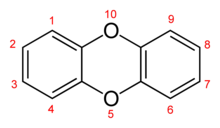Polyfluorinated dibenzodioxins and dibenzofurans
Polyfluorinated dibenzodioxins and dibenzofurans (PFDD / PFDF) are a group of chemicals whose structure corresponds to the polychlorinated dibenzodioxins and -furans . So far, they have not been detected in environmental samples; their formation during combustion processes is considered unlikely. In animal experiments, their accumulation in the thymus and their rapid degradation compared to other dioxins were noticeable.
Emergence
Polyfluorinated dibenzodioxins and dibenzofurans could be produced in the laboratory by the pyrolysis of fluorophenols and fluorobenzenes . When Teflon and materials containing Teflon were burned, no formation of PFDDs / PFDFs could be determined. Even when trichlorofluoromethane was heated in the presence of a catalyst, no fluorinated dioxins or furans were formed.
No fluorinated dibenzodioxins and dibenzofurans could be detected in the fly ash from waste incineration plants. A “de novo synthesis” in combustion processes in the presence of carbon compounds and fluorine salts is considered unlikely. Connections between carbon and fluorine atoms only form at temperatures above 900 ° C, but at these temperatures dioxins are already broken down again.
Chlorinated fluorinated (mixed halogenated) dibenzofurans and biphenyls were found in the filter dust from an aluminum melt that Freon12 used . The procedure was changed after the CFC ban in 1992.
properties
The molecules of fluorinated dibenzodioxins and dibenzofurans are slightly smaller than those of the chlorinated dioxins and furans because the fluorine atom has a smaller van der Waals radius (1.35 Å ) than the chlorine atom (1.8 Å). When analyzing with a gas chromatograph , fluorinated dibenzodioxins and furans pass through the separation column faster than chlorinated PCDD / PCDF. The reason for this is the low polarizability of the fluorine atom.
toxicology
In animal experiments, mice were able to degrade injected 2,3,7,8-tetrafluorodibenzodioxin (2,3,7,8-TFDD) very quickly. It was noticeable that the degradation took place in two phases: the 2,3,7,8-TFDD disappeared from the blood in the “fast phase” with a half-life of 5 minutes, in the subsequent “slow phase” the concentration decreased with it a half-life of 165 minutes. In the liver, too, the concentration of 2,3,7,8-TFDD decreased in two phases, here the half-life of the “slow phase” was about 4.5 hours. The "fast phase" is possibly due to the storage in the fatty tissue, the "slow phase" indicates a breakdown by the metabolism . The half-life for the degradation of the chlorinated 2,3,7,8-tetrachlorodibenzodioxin , however, is 8.5 days.
In experiments on rat liver cells , 2,3,7,8-tetrafluorodibenzodioxin had a recognizable effect ( EC 50 ) at similar concentrations as its chlorinated counterpart 2,3,7,8-TCDD. The lower stability in the blood and liver suggests that 2,3,7,8-TFDD is less dangerous than 2,3,7,8-TCDD.
In the rat, the 2,3,7,8-substituted PFDD / PFDF, unlike their chlorinated counterparts, accumulate in the thymus . This indicates a possible immunosuppressive effect.
Individual evidence
- ↑ a b c d e R. Weber, D. Schrenk, H.-J. Schmitz, A. Hagenmaier, H. Hagenmaier: Polyfluorinated Dibenzodioxins and Dibenzofurans - Synthesis, Analysis, Formation and Toxikology , Chemosphere , 1995, Vol. 30, No. 4, pp. 629-639; PMID 7889348 .
- ↑ Roland Weber, Hanspaul Hagenmaier : Synthesis and analysis of mixed chlorinated-fluorinated dibenzo-p-dioxins and dibenzofurans and assessment of formation and occurrence of the fluorinated and chlorinated-fluorinated dibenzo-p-dioxins and dibenzofurans , Chemosphere, Vol. 34, No. January 1, 1997, pp. 13-28; PMID 9011027 .
- ↑ R. Weber, HJ Schmitz, D. Schrenk, H. Hagenmaier: Metabolic degradation, inducing potency, and metabolites of fluorinated and chlorinated-fluorinated dibenzodioxins and dibenzofurans , Chemosphere, January 1997, Vol. 34 (1), p. 29– 40; PMID 9011028 .
- ↑ D. Herzke, R. Thiel, WD Rotard, D. Neubert: Kinetics and organotropy of some polyfluorinated dibenzo-p-dioxins and dibenzofurans (PFDD / PFDF) in rats , Life Sciences , Vol. 71, No. 13, 16. August 2002, pp. 1475-1486; PMID 12127903 .

